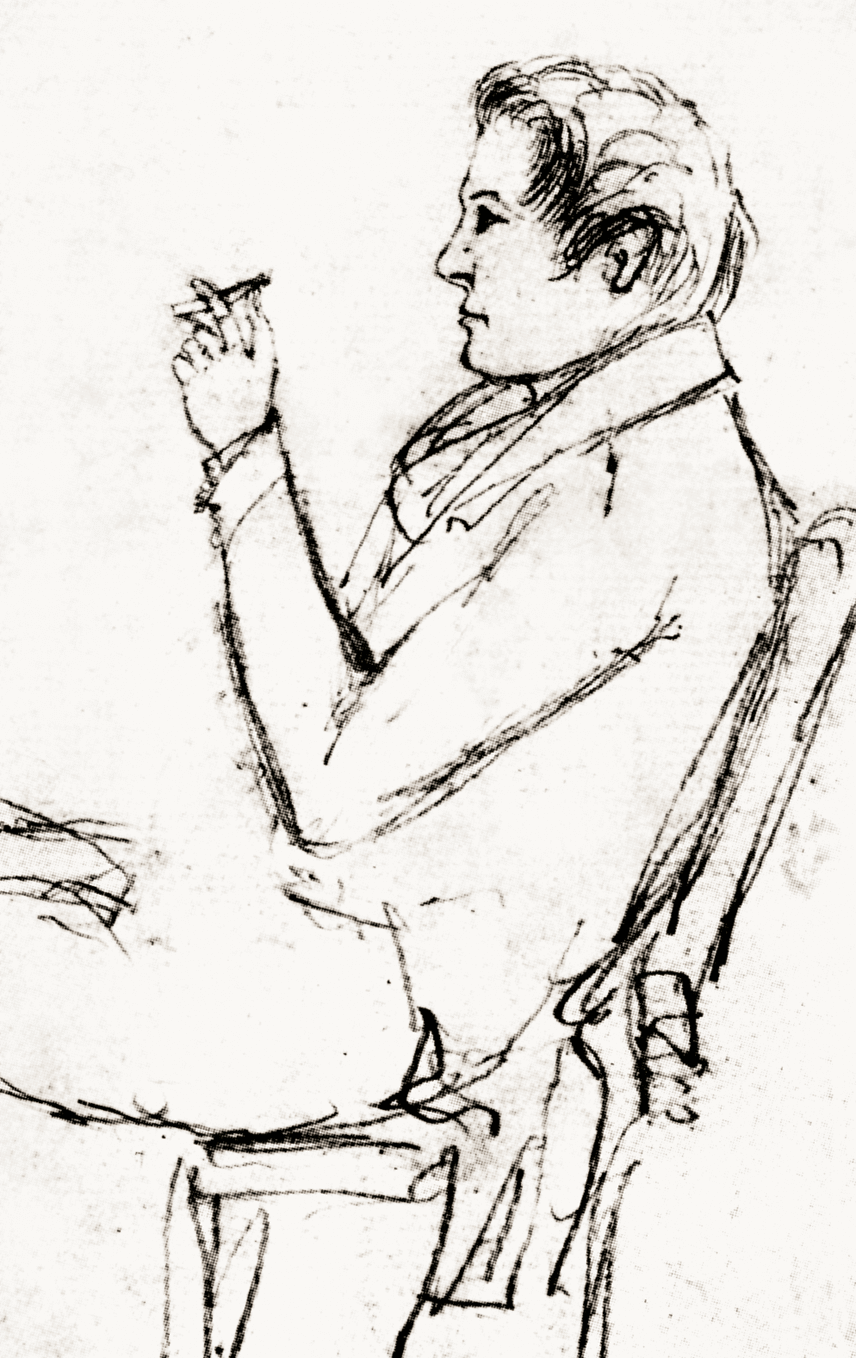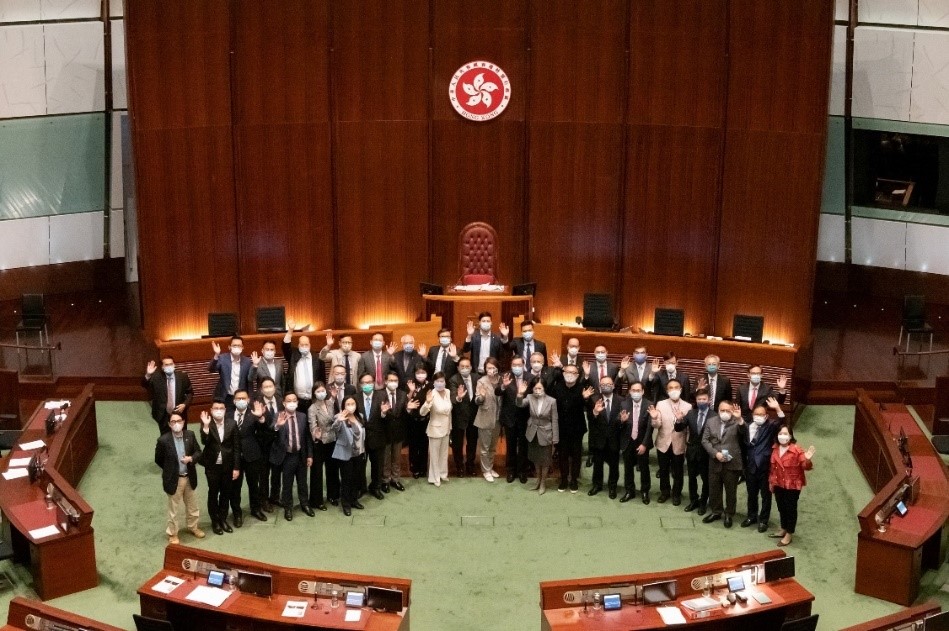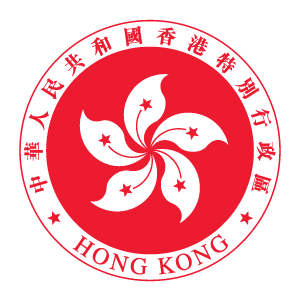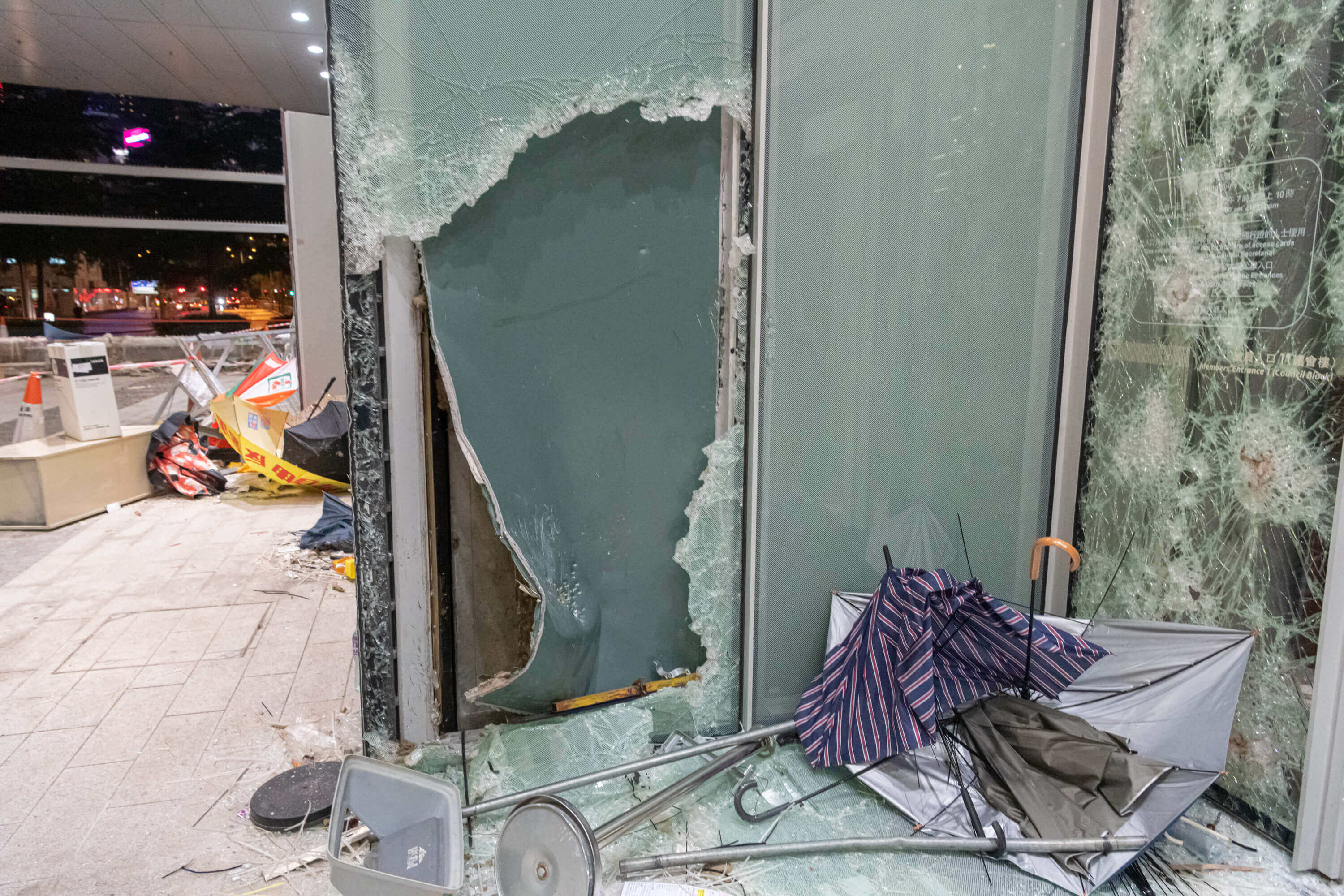-
1843-1845Founding of Legislative CouncilThe Legislative Council was established in 1843. It mainly played an advisory role to the Governor of Hong Kong on law-making matters.
-
1843Establishment of Legislative Council
The island of Hong Kong officially came under British rule in 1843. Hong Kong's pre-1997 constitutional framework was set out in the Letters Patent and the Royal Instructions promulgated by Queen Victoria in 1843. The Letters Patent authorized the establishment of the Governor, the Executive Council and the Legislative Council ("LegCo") and empowered the Governor to make and enact laws and ordinances with the advice of LegCo. The Royal Instructions spelt out the role and responsibilities of the Governor and the two Councils, as well as the constitution of the two Councils and the rules and procedures of LegCo for the enactment of laws and ordinances.
 The Letters Patent provided the first constitutional framework of Hong Kong. (Replica)
The Letters Patent provided the first constitutional framework of Hong Kong. (Replica)
(Source from The National Archives of the UK (TNA): Public Record Office (PRO) C 66/4683) -
1844Earliest LegCo sitting
LegCo was first formed with a composition of three Official Members and the Governor as President of the Council. Due to an outbreak of fever, the earliest LegCo sitting was not convened until January 1844. It was chaired by Governor Henry POTTINGER, and attended by two Official Members.
The first Hong Kong Ordinance, No.1 of 1844, relating to slavery, was passed on 28 February 1844.
-
1845First version of Standing Orders and Rules for LegCo
The first version of Standing Orders and Rules for the Legislative Council of Hong Kong was adopted in pursuance of Article 6 of the Royal Instructions of 1843.
-
1846-1944Early development of the LegislatureDuring this period, Unofficial Members were appointed. The year 1888 saw a significant change to the Letters Patent that made it mandatory for the Governor to obtain the consent of LegCo in law-making.
-
1850First two Unofficial Members
The first two Unofficial Members, David JARDINE and Joseph Frost EDGER, were appointed to LegCo with the aim of broadening community representation in the Council.
 David JARDINE (1818-1856).
David JARDINE (1818-1856).
(Courtesy of the Jardine Matheson Group) -
1880First Chinese Unofficial Member
In early 1880, barrister NG Choy (also known as WU Ting-fang) was provisionally appointed to fill a temporary vacancy, making him the first Chinese Unofficial Member. After NG Choy’s resignation in 1882 before the expiry of his term of office, Governor George BOWEN supported the principle of introducing Chinese membership to LegCo and later officially appointed WONG Shing as the Chinese Unofficial Member of the Council in 1884. In the following years, LegCo continued to expand its membership to include more Official and Unofficial Members.
-
1888Amendments to the Letters Patent
The Letters Patent were amended and became effective on 19 January 1888. Under the revised article, the Governor was required not only to seek the advice but also the consent of LegCo in enacting laws.
-
1890Publication of the Hong Kong Hansard
It is not known when the Hong Kong Hansard, the official verbatim reports of sittings of LegCo, was first published but copies existed from 1890 onwards.
-
1941Adjournment of LegCo sitting
On 13 November 1941, Governor Mark YOUNG held the Council’s last sitting before the Japanese occupation of Hong Kong. The sitting was adjourned sine die (until further notice).
 Sir Mark YOUNG, Governor in 1941-1947.
Sir Mark YOUNG, Governor in 1941-1947.
(Courtesy of the HKSAR Government) -
1945-1983Development of the Legislature after war yearsGovernor Mark YOUNG proposed changes to the structure of LegCo soon after the Council had resumed its sittings in 1946, but his proposals were abandoned in 1949. In 1964, the numbers of Official Members and Unofficial Members were the same for the first time in the history of LegCo.
-
1946Resumption of LegCo
On 1 May 1946, LegCo resumed and held its first sitting on the same day. Governor Mark YOUNG later put forward the "Young Plan", which contained proposals on changes to the structure of LegCo, with seven Official Members and eight Unofficial Members, in addition to the Governor. The plan was abandoned in 1949.
 Major-General Umekichi OKADA delivered his sword as a symbol of surrender of Japan.
Major-General Umekichi OKADA delivered his sword as a symbol of surrender of Japan.
(Courtesy of Library and Archives Canada: PA-114815) -
1963Establishment of UMELCO
The Office of the Unofficial Members of the Executive and Legislative Councils ("UMELCO") was established to promote closer relationship between members of the public and the Unofficial Members of the two Councils.
.png) The emblem of UMELCO.
The emblem of UMELCO. -
1964Numbers of Official and Unofficial Members
Membership of LegCo was increased from 18 to 26. For the first time, the numbers of Official Members and Unofficial Members were the same.
-
1965First female Unofficial Member
Mrs Ellen LI Shu-pui, the first female Unofficial Member of LegCo, was appointed.
 Mrs Ellen LI Shu-pui (1908-2005).
Mrs Ellen LI Shu-pui (1908-2005).
(Courtesy of Dr Ellen Li Charitable Foundation) -
1976First "grassroots" LegCo Member
WONG Lam, an employee of the Kowloon Motor Bus Company, was appointed an Unofficial Member. He became the first "grassroots" LegCo Member.
 The Member’s identification pass issued to WONG Lam (1919-2016) (Replica).
The Member’s identification pass issued to WONG Lam (1919-2016) (Replica).
(Source from WONG Lam) -
1984-1997The Legislature before the HandoverThe Sino-British Joint Declaration on the Question of Hong Kong was signed in 1984. In the following year, some LegCo Members were returned for the first time by indirect election. In 1991, the first batch of directly elected Members was returned. The first fully elected Legislature in Hong Kong was formed in 1995.
-
1984Signing of the Sino-British Joint Declaration
In accordance with the Joint Declaration of the Government of the United Kingdom of Great Britain and Northern Ireland and the Government of the People's Republic of China on the Question of Hong Kong ("Joint Declaration") signed in 1984, China would resume the exercise of sovereignty over Hong Kong with effect from 1 July 1997. The Joint Declaration also sets out the basic policies of the People's Republic of China regarding Hong Kong. These basic policies shall be stipulated in the Basic Law of the Hong Kong Special Administrative Region of the People’s Republic of China ("Basic Law").
-
1985First LegCo indirect election
Following the release of the Green Paper on the Further Development of Representative Government in Hong Kong in July 1984, election was held for the first time in 1985 for returning LegCo Members.
Composition of LegCo in 1985Mode Source of candidate Number Elected from an electoral college constituency (10)
from functional constituencies (12)
from Urban Council (1)
from Regional Council (1)24 Appointed 22 Official 11 Total 57 Home of LegCo in the former Supreme Court BuildingLegCo took over occupation of the former Supreme Court Building in Central in 1985. The building, opened in 1912, was converted into the home of LegCo. Before 1985, the Council met at the LegCo Chamber in the Main Wing of the Central Government Offices.
Powers and privileges of LegCoThe Legislative Council (Powers and Privileges) Ordinance (Cap. 382) was enacted. It defines the immunities and privileges enjoyed by the Council and its Members to facilitate the performance of parliamentary duties. It also empowers the Council and standing committees to order the attendance of witnesses to give evidence or produce documents, and enables the same power to be given to any other committee by resolution of the Council.

-
1991First LegCo direct election
Eighteen Members were returned by direct election in nine geographical constituencies. Among the 18 elected Members, Emily LAU Wai-hing was the first female Member returned by direct election. Directly elected Members aside, there were four ex-officio Members, 18 appointed Members and 21 Members returned by functional constituencies.
-
1993Governor ceased to be the President of LegCo
The last Governor, Christopher PATTEN, ceased to be the President of LegCo. He handed over the presidency to a Member elected from and among Unofficial Members. Sir John J SWAINE was the first elected President of LegCo.
 Sir John J SWAINE (1932-2012).
Sir John J SWAINE (1932-2012).
(Courtesy of the HKSAR Government) -
1994Establishment of The Legislative Council Commission
The statutory Legislative Council Commission was established under The Legislative Council Commission Ordinance (Cap. 443). The Ordinance also provides the legal framework for the Commission and the new independent LegCo Secretariat, under the supervision of the Commission, to operate with managerial and financial autonomy to provide administrative support and services to the Council.
-
1995First fully elected Legislature
The first fully elected Legislature in Hong Kong was composed of 60 Members. It was also the last LegCo before Hong Kong’s return to China.
-
1997Last LegCo under British rule
The original intent of the Basic Law was to allow Members of the last LegCo under British rule to sit on the first LegCo of the Hong Kong Special Administrative Region ("HKSAR") automatically if the electoral methods for returning these Members complied with the Basic Law and the decision passed by the National People’s Congress on 4 April 1990. As the condition was not met, the term of the last LegCo under British rule ended on 30 June 1997.
 Photo of Members taken after the last LegCo sitting before Hong Kong’s return to China.
Photo of Members taken after the last LegCo sitting before Hong Kong’s return to China.
(Courtesy of the HKSAR Government) -
1996-1998Transitional yearsThe Provisional LegCo was established in 1996 as an interim Legislature for Hong Kong.
-
1996Establishment of the Provisional LegCo
The Provisional LegCo was established in December 1996 as an interim Legislature for Hong Kong to pass laws necessary for the establishment of the HKSAR.
All the 60 Members of the Provisional LegCo were elected by a 400-member Selection Committee for the First Government of the HKSAR. The Council held its first meeting on 25 January 1997 in Shenzhen and completed its work in June 1998.
-
1997Passage of the Hong Kong Reunification Bill
On 1 July 1997, the Provisional LegCo held a meeting immediately after the Handover Ceremony to pass the Hong Kong Reunification Bill.
Passage of the Legislative Council BillOn 28 September 1997, the Provisional LegCo passed the Legislative Council Bill, which provides for the constitution, convening and dissolution of LegCo, to enable the first LegCo of the HKSAR to be established.
-
1998 and onwardsLegislative Council of the HKSARThe HKSAR was established immediately after Hong Kong's return to China in 1997. In the following year, the First LegCo of the HKSAR was established. The membership of LegCo was expanded from 60 to 70 in 2012, and to 90 in 2022.
-
1998Establishment of the First LegCo of the HKSAR
Following Hong Kong’s return to China on 1 July 1997, the HKSAR was established. The Basic Law came into effect and it provides for the constitutional framework of LegCo of the HKSAR.
In accordance with the Basic Law, the First LegCo of the HKSAR was established in 1998 and the first meeting was held on 2 July 1998. At the meeting, Mrs Rita FAN HSU Lai-tai was elected President of LegCo.
-
1998Method for the formation of LegCo
The method for the formation of LegCo is specified in Annex II to the Basic Law. According to Annex II to the Basic Law adopted at the Third Session of the Seventh National People’s Congress on 4 April 1990, LegCo shall be composed of 60 Members for each term. The composition of LegCo in the first, second and third terms shall be as follows:
Members First LegCo (1998-2000) Second LegCo (2000-2004) Third LegCo (2004-2008) Members returned by functional constituencies 30 30 30 Members returned by the Election Committee 10 6 - Members returned by geographical constituencies 20 24 30 -
2005Vetoing of the constitutional reform package
The Government put forward a constitutional reform package proposing to expand the membership of LegCo from 60 to 70 in 2008 with five new seats each to be returned by geographical constituencies through direct elections and by functional constituencies. The motion concerning the amendment to the method for the formation of LegCo was vetoed by the Council on 21 December 2005.
-
2008Composition of the Fourth LegCo
As the constitutional reform package put forward in 2005 was vetoed, the composition of the Fourth LegCo (2008-2012) remained unchanged.
Members Fourth LegCo (2008-2012) Members returned by functional constituencies 30 Members returned by geographical constituencies 30  Group photo of LegCo Members (2008-2012).
Group photo of LegCo Members (2008-2012).
(Courtesy of the HKSAR Government) -
2010Endorsement of the constitutional reform package
In April 2010, a new constitutional reform package on the methods for selecting the Chief Executive and for forming LegCo in 2012 was presented to the Council. On 25 June 2010, the motion concerning the amendment to the method for the formation of LegCo and its voting procedures (Annex II to the Basic Law) was endorsed by the Council. With the consent of the Chief Executive, the amendment was reported to the Standing Committee of the National People’s Congress ("NPCSC") for the record.
 The motion concerning the amendment to the method for the formation of LegCo was endorsed by LegCo in 2010.
The motion concerning the amendment to the method for the formation of LegCo was endorsed by LegCo in 2010.
(Courtesy of the HKSAR Government) -
2012Composition of the Fifth LegCo
The constitutional reform package put forward in 2010 was endorsed. The Fifth LegCo (2012-2016) was composed of 70 Members, equally distributed between functional constituencies (35) and geographical constituencies (35).
Members Fifth LegCo (2012-2016) Members returned by functional constituencies 35 Members returned by geographical constituencies 35  Group photo of LegCo Members (2012-2016).
Group photo of LegCo Members (2012-2016). -
2014Formulation of the Policy on Access to the Legislature's Documents and Records
The Council passed a resolution on 19 March 2014 to amend the Rules of Procedure ("RoP") to set out the Council's Policy on Access to the Legislature's Documents and Records and to establish the Committee on Access to the Legislature's Documents and Records to oversee the implementation of the Policy. This Policy provides, among other things, that all closed documents and records will be available for public access 50 years after they have been in existence as long as the disclosure is not prohibited by the law. Access to any other documents or records may be made available at any time but must be made so available when they have been in existence for 20 years.
 LegCo attaches great importance to the promotion of openness and public access to information.
LegCo attaches great importance to the promotion of openness and public access to information. -
2015Vetoing of the electoral reform package
In April 2015, the Government published the Consultation Report and Proposals on the Method for Selecting the Chief Executive by Universal Suffrage, including the draft motion to be put to the Council. Among the main elements was a two-stage nominating process that would accept five to 10 initial nominees, from which a 1 200-member Nominating Committee would choose two or three candidates. All electors might then cast their votes on the shortlisted candidates. The motion concerning the amendment to the method for the selection of the Chief Executive was vetoed by the Council on 18 June 2015.
-
2016Interpretation of Article 104 of the Basic Law on oath-taking
Controversies arose from the oath-taking by Members at the first Council meeting of the Sixth LegCo held on 12 October 2016. In November 2016, the NPCSC made an interpretation of Article 104 of the Basic Law which provides that oath-taking is the legal prerequisite for Members to assume office, and an oath-taker who intentionally reads out words which do not accord with the wording of the oath prescribed by law, or takes the oath in a manner which is not sincere or not solemn shall be treated as declining to take the oath and is disqualified from assuming the public office.
 Oath-taking is the legal prerequisite for LegCo Members to assume office.
Oath-taking is the legal prerequisite for LegCo Members to assume office. -
2017Substantive amendments to the Rules of Procedure
Since the Fourth LegCo, there have been calls for amendment to RoP to deal with filibusters. The Council passed on 15 December 2017 two resolutions to amend 50 Rules in RoP, including quorum of a committee of the whole Council, as well as the President's power to reconvene a Council meeting to complete the unfinished business on the agenda after the adjournment of the Council because of a lack of a quorum.
 The Rules of Procedure provide detailed directions on how business is transacted in LegCo and committee meetings.
The Rules of Procedure provide detailed directions on how business is transacted in LegCo and committee meetings. -
2019Intrusion into the LegCo Complex
The Chief Executive announced on 15 June 2019 the suspension of the legislative amendment exercise on the controversial Fugitive Offenders and Mutual Legal Assistance in Criminal Matters Legislation (Amendment) Bill 2019. However, large-scale public demonstrations continued. On 1 July 2019, the LegCo Complex was intruded and vandalized by demonstrators, causing serious damage to the glass curtain walls of the Complex and various facilities.
-
2020Term of office of the Sixth LegCo
In view of the severe COVID-19 epidemic situation, the Government postponed the general election for the Seventh LegCo. To address the issue arising from the postponement of the election, the NPCSC made the decision to let the Sixth LegCo continue to discharge its duties for no less than one year until the commencement of the Seventh LegCo.
 Photo of Members taken after the last Council meeting of the Sixth LegCo held on 27 October 2021.
Photo of Members taken after the last Council meeting of the Sixth LegCo held on 27 October 2021. -
2021Amendments to the method for the formation of LegCo
In March 2021, the National People’s Congress passed the Decision on Improving the Electoral System of the HKSAR ("Decision") and authorized the NPCSC to amend Annex I to the Basic Law on Method for the Selection of the Chief Executive of the HKSAR and Annex II to the Basic Law on Method for the Formation of LegCo of the HKSAR and Its Voting Procedures. As specified in the amended Annex II, LegCo shall be composed of 90 Members for each term, returned by the Election Committee (40), functional constituencies (30) and geographical constituencies through direct elections (20).
To implement the Decision and the amended Annexes I and II to the Basic Law adopted by the NPCSC, the Improving Electoral System (Consolidated Amendments) Bill 2021 was introduced into LegCo on 14 April 2021 to amend certain electoral legislation. The Bill was subsequently passed by LegCo on 27 May 2021.

-
2021Review of the Rules of Procedure and House Rules
The rules and practices of LegCo were reviewed in phases with a view to achieving the orderly, efficient and fair disposition of Council business. The Council passed resolutions to amend a wide span of Rules in RoP, including sanction against grossly disorderly conduct of Members, committee membership, and the administration of LegCo Oath. The House Committee also endorsed the consequential amendments to the House Rules.
-
2022Composition and commencement of the Seventh LegCo
The method for the formation of LegCo (Annex II to the Basic Law) was amended by the NPCSC in 2021. The Seventh LegCo (2022-2025), commenced on 1 January 2022, is composed of 90 Members.
Members Seventh LegCo (2022-2025) Members returned by the Election Committee 40 Members returned by functional constituencies 30 Members returned by geographical constituencies 20


Website
Members
Committees
Bills
LegCo Databases
-
- |
-











.jpg)
.jpg)
.png)


.jpg)
.png)
.png)


.jpg)

